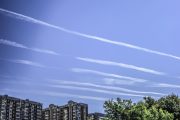In fact, about 8 percent of man-made worldwide carbon dioxide emissions are due to simple human breathing. The EPA says they do not want to regulate this activity … for now. But there’s no chemical difference between CO2 emitted from a gasoline engine and that emitted from a human lung.
The proposed new regulations are the result of a lawsuit by former Massachusetts Attorney General Thomas F. Reilly that took the EPA to the U.S. Supreme Court. The Supreme Court ruled in the 2007 case of Massachusetts v. EPA that the EPA should draw up proposed regulations of so-called “greenhouse gases” that are emitted by automobiles. Four of the proposed “pollutants” to be regulated by the EPA in this 133-page proposal are emitted by automobiles, but two have no connection to the Supreme Court decision.
The new leaders of the EPA under the Obama administration saw the Supreme Court’s ruling as a green light to regulate almost every aspect of human conduct. The EPA’s website noted with glee that the Supreme Court said that the Clean Air Act had a “sweeping definition of ‘air pollutant’” that included “without a doubt ‘physical [and] chemical … substances which [are] emitted into … the ambient air.’ The statute is unambiguous.”
And it doesn’t matter to the EPA whether or not Congress votes to authorize the proposed regulations. They’re going ahead anyway, leaving it to Congress to cast a negative vote if it doesn’t like any sweeping regulations the EPA issues. Leftists in Congress are cheering the EPA ruling. “It now changes the playing field with respect to legislation. It’s now no longer doing a bill or doing nothing. It is now a choice between regulation and legislation,” Massachusetts Congressman Ed Markey told the Associated Press. Of course, this approach (regulations going into effect unless blocked by Congress) contradicts Article One, Section One, Clause One of the Constitution, which Markey and all other congressmen have pledged to support and defend.
How does the EPA go about declaring carbon dioxide — a common and healthy gas needed for plant life on Earth — a dangerous “pollutant”? They redefine “pollutant” thusly:
To clarify the distinction between air pollution and air pollutant, the air pollution is the atmospheric concentrations and can be thought of as the total, cumulative stock problem of greenhouse gases in the atmosphere. The air pollutants, on the other hand, are the emissions of greenhouse gases and can be thought of as the flow that changes the size of the total stock.
Translated from bureaucratese, it means that carbon dioxide, methane and other alleged “pollutants” aren’t dangerous and are in fact natural elements. But the fact that human activities such as breathing and car exhaust add to the global amount of carbon dioxide means that CO2 emissions should be regulated, according to the EPA.
How powerful is the EPA about to become? They’ve essentially been given the power to regulate the periodic table of the elements. But even though they took 133 pages to say they would regulate six of the most common chemical compounds in nature, there are no specifics about what would be regulated or what standards would be upheld. They need to establish the principle first.
The excuse for the EPA’s need for regulatory powers is the “threat” of global warming. Though even the EPA admits the Earth has heated up only 1.25 degrees in the last 100 years, the agency assumes that any continued warming is going to be catastrophic. The EPA even claims that continued global warming would cause “increased drought” while at the same time creating “more heavy downpours and flooding.” If global warming is real, then it can’t create more rain and less rain at the same time.
The EPA ignored the evidence presented by top scientists who claim that carbon dioxide will not cause any type of climate catastrophe. Besides, any sort of climate change is bound to have both positive and negative side effects. The Wall Street Journal’s Keith Johnson noted that there are some positive effects of rising greenhouse gases: “One is faster-growing trees in tropical forests, which helps offset deforestation. Another is marshes that can more quickly grow above rising sea levels, providing an insurance policy of sorts for some low-lying areas against the potential ravages of rising sea levels resulting from warmer global temperatures.”
The EPA proposal would also regulate methane (CH4), which all humans produce naturally when they “break wind,” nitrous oxide (N2O), hydrofluorocarbons (HFCs), perfluorocarbons (PFCs), and sulfur hexafluoride (SF6).




